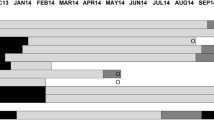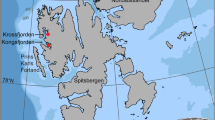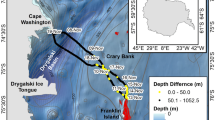Abstract
Knowledge on how divers exploit the water column vertically in relation to water depth is crucial to our understanding of their ecology and to their subsequent conservation. However, information is still lacking for the smaller-bodied species, due mostly to size constraints of data-loggers. Here, we report the diving behaviour of a flying diving seabird, the Cape Cormorant Phalacrocorax capensis, weighing 1.0–1.4 kg. Results were obtained by simultaneously deploying small, high resolution and high sampling frequency GPS and time-depth loggers on birds breeding on islands off Western South Africa (34°S, 18°E) in 2008. In all, dive category was assigned to all dives performed by 29 birds. Pelagic dives occurred almost as frequently as benthic dives. Pelagic dives were shallow (mean: 5 m) and took place over seafloors 5–100 m deep. Benthic dives were deeper, occurring on seafloors mainly 10–30 m deep. Dive shape was linked to dive category in only 60% of dives, while the descent rate, ascent rate and bottom duration/dive duration ratio of a dive best explained its dive category. This shows that only the concomitant use of tracking and depth tags can adequately classify diving strategies in a diver like the Cape Cormorant. Diet was mainly Cape Anchovy Engraulis encrasicolis, suggesting that birds probably displayed two contrasted strategies for capturing the same prey. Flexible foraging techniques represent an important key to survival inside the highly productive but heterogeneous Benguela upwelling ecosystem.








Similar content being viewed by others
References
Bailleul F, Charassin JB, Monestiez P, Roquet F, Biuw M, Guinet C (2007) Successful foraging zones of southern elephant seals from the Kerguelen Islands in relation to oceanographic conditions. Phil Trans Roy Soc B 362:2169–2181
Beauplet G, Dubroca L, Guinet C, Cherel Y, Dabin W, Gagne C, Hindell M (2004) Foraging ecology of subantarctic fur seals Arctocephalus tropicalis breeding on Amsterdam Island: seasonal changes in relation to maternal characteristics and pup growth. Mar Ecol Progr Ser 273:211–225
Berry HH (1976) Physiological and behavioural ecology of the Cape cormorant Phalacrocorax capensis. Modoqua 9:5–55
Bost CA, Zorn T, Le Maho Y, Duhamel G (2002) Feeding of diving predators and diel vertical migration of prey: king penguin diet versus trawl sampling at Kerguelen islands. Mar Ecol Prog Ser 227:51–61
Bost C-A, Handrich Y, Butler PJ, Fahlman A, Halsey LG, Woakes AJ, Ropert-Coudert Y (2007) Changes in dive profiles as an indicator of feeding success in king and Adélie penguins. Deep Sea Res II 54:248–255
Bost C-A, Cotté C, Bailleul F, Cherel Y, Charrassin JB, Guinet C, Ainley DG, Weimerskirch H (2009) The importance of oceanographic fronts to marine birds and mammals of the southern oceans. J Mar Syst 79:363–376
Charrassin J-B, Young-Hyang P, Le Maho Y, Bost C-A (2004) Fine resolution 3D temperature fields off Kerguelen from instrumented penguins. Deep Sea Res I 51:2091–2103
Cook TR, Cherel Y, Bost C-A, Tremblay Y (2007) Chick-rearing Crozet shags (Phalacrocorax melanogenis) display sex-specific foraging behaviour. Antarct Sci 19:55–63
Cook TR, Lescroël A, Tremblay Y, Bost C-A (2008) To breathe or not to breathe? Optimal breathing, aerobic dive limit and oxygen stores in deep diving blue-eyed shags. Anim Behav 76:565–576
Cook TR, Kato A, Tanaka H, Ropert-Coudert Y, Bost C-A (2010) Buoyancy under control: underwater locomotor performance in a deep diving seabird suggests respiratory strategies for reducing foraging effort. PLoS ONE 5:e9839
Crawford RJM (2005) Cape Cormorant Phalacrocorax capensis. In: Hockey PAR, Dean WRJ, Ryan PG (eds) Roberts: birds of southern Africa. The Trustees of the John Voelcker Bird Book Fund, Cape Town, pp 579–580
Crawford RJM (2007) Food, fishing and seabirds in the Benguela upwelling system. J Ornithol 48:S253–S260
Crawford RJM, Dyer BM (1995) Responses by four seabird species to a fluctuating availability of Cape Anchovy Engraulis capensis off South Africa. Ibis 137:329–339
de Brooke ML (2004) The food consumption of the world’s seabirds. Biol Lett 271:S246–S248
Duffy DC (1983) Environmental uncertainty and commercial fishing: effects on Peruvian guano birds. Biol Conserv 26:227–238
Enstipp MR, Grémillet D, Lorentsen S-H (2005) Energetic costs of diving and thermal status in European shags (Phalacrocorax aristotelis). J Exp Biol 208:3451–3461
Gaston AJ, Jones IL (1998) The auks. Oxford University Press, Oxford
Hamer KC, Humphreys EM, Magalhaes MC, Garthe S, Hennicke J, Peters G, Grémillet D, Skov H, Wanless S (2009) Fine-scale foraging behaviour of a medium-ranging marine predator. J Anim Ecol 78:880–889
Hays GC, Houghton JDR, Isaacs C, King RS, Lloyd C, Lovell P (2004) First oceanic dive profiles for leatherback turtles, Dermochelys coriacea, indicate behavioural plasticity associated with long distance migration. Anim Behav 67:733–743
Hazel J (2009) Evaluation of fast-acquisition GPS in stationary tests and fine-scale tracking of green turtles. J Exp Mar Biol Ecol 74:58–68
Hill T, Lewicki P (2006) Statistics: methods and applications. A comprehensive reference for science, industry, and data mining. StatSoft, Tulsa
Houston AI, Carbone C (1992) The optimal allocation of time during the diving cycle. Behav Ecol 3:255–265
James AG (1987) Feeding ecology, diet and field-based studies on feeding electivity of the Cape anchovy Engraulis capensis Gilchrist. South Afr J Mar Sci 5:673–692
Jennrich RI (1977) Stepwise discriminant analysis. In: Enslein K, Ralston A, Wilf HS (eds) Statistical methods for digital computers. Wiley, New York, pp 76–95
Kato A, Watanuki Y, Naito Y (1998) Benthic and pelagic foraging of two Japanese cormorants, determined by simultaneous recording of location and diving activity. J Yamashina Instit Ornithol 30:101–108
Kato A, Ropert-Coudert Y, Grémillet D, Cannell B (2006) Locomotion and foraging strategy in foot-propelled and wing-propelled shallow-diving seabirds. Mar Ecol Progr Ser 308:293–301
Kotzerka J, Hatch SA, Garthe S (2011) Evidence for foraging-site fidelity and individual foraging behavior of Pelagic Cormorants rearing chicks in the Gulf of Alaska. Condor 113:80–88
Kramer DL (1988) The behavioral ecology of air breathing by aquatic animals. Canad J Zool 66:89–94
Masello JF, Mundry R, Poisbleau M, Demongin L, Voigt C, Wikelski M, Quillfeldt P (2010) Diving seabirds share foraging space and time within and among species. Ecosphere 1:19
Montevecchi WA (2002) Interactions between fisheries and seabirds. In: Schreiber EA, Burger J (eds) Biology of Marine Birds. CRC Press, New York, pp 527–556
Mori Y (2002) Optimal diving behaviour for foraging in relation to body size. J Evol Biol 15:269–276
Nelson JB (2006) Pelicans, cormorants, and their relatives. The pelecaniformes. Oxford University Press, Oxford
Phillips RA, Xavier JC, Croxall JP (2003) Effects of satellite transmitters on albatrosses and petrels. Auk 120:1082–1090
Preston TJ, Chiaradia A, Caarels SA, Reina RD (2010) Fine scale biologging of an inshore marine animal. J Exp Mar Biol Ecol 390:196–202
Quillfeldt P, Schroff S, Van Noordwijk HJ, Michalik A, Ludynia K, Masello JF (2011) Flexible foraging behavior of a sexually dimorphic seabird: large males do not always dive deep. Mar Ecol Prog Ser 428:271–287
Ray GC, McCormick-Ray J, Berg P, Epstein HE (2006) Pacific walrus: benthic bioturbator of Beringia. J Exp Mar Biol Ecol 330:403–419
Ribak G, Weihs D, Arad Z (2004) How do cormorants counter buoyancy during submerged swimming? J Exp Biol 207:2101–2114
Ribak G, Weihs D, Arad Z (2005) Submerged swimming of the great cormorant Phalacrocorax carbo sinensis is a variant of the burst-and-glide gait. J Exp Biol 208:3835–3849
Ropert-Coudert Y, Wilson RP (2005) Trends and perspectives in animal-attached remote sensing. Front Ecol Environ 3:437–444
Ropert-Coudert Y, Grémillet D, Kato A (2005) Diving angle of great cormorants. Polar Biosci 18:54–59
Ropert-Coudert Y, Grémillet D, Kato A (2006) Swim speeds of free-ranging great cormorants. Mar Biol 149:415–422
Ropert-Coudert Y, Knott N, Chiaradia A, Kato A (2007) How do different data logger sizes and attachment positions affect the diving behaviour of little penguins? Deep Sea Res II 54:415–423
Ryan PG, Pichegru L, Ropert-Coudert Y, Grémillet D, Kato A (2010) On a wing and a prayer: the foraging ecology of breeding Cape cormorants. J Zool 280:25–32
Schmid D, Grémillet DJH, Culik BM (1995) Energetics of underwater swimming in the great cormorant (Phalacorcorax carbo sinensis). Mar Biol 123:875–881
Schreer JF, Kovacs KM, O’Hara Hines RJ (2001) Comparative diving patterns of pinnipeds and seabirds. Ecol Monogr 71:137–162
Shaffer SA, Tremblay Y, Weimerskirch H, Scott D, Thompson DR, Sagar PM, Moller H, Taylor GA, Foley DG, Block BA, Costa DP (2006) Migratory shearwaters integrate oceanic resources across the Pacific Ocean in an endless summer. Proc Nat Acad Sci 103:12799–12802
Shannon LJ, Cochrane KL, Moloney CL, Fréon P (2004) Ecosystem approach to fisheries management in the southern Benguela: a workshop overview. Afr J Mar Sci 26:1–8
Shannon V, Hempel G, Moloney C, Woods J, Malanotte-Rizzoli P (2006) Benguela: predicting a large marine ecosystem. Elsevier, Oxford
Sheppard JK, Preen AR, Marsh H, Lawler I, Whiting SD, Jones RE (2006) Movement heterogeneity of dugongs, Dugong dugon (Müller), over large spatial scales. J Exp Mar Biol Ecol 334:64–83
Shiomi K, Narazaki T, Sato K, Shimatani K, Arai N, Ponganis P, Miyazaki N (2010) Data-processing artefacts in three-dimensional dive path reconstruction from geomagnetic and acceleration data. Aquat Biol 8:289–294
Takahashi A, Dunn MJ, Trathan PN, Sato K, Naito Y, Croxall JP (2003) Foraging strategies of chinstrap penguins at Signy Island, Antarctica: importance of benthic feeding on Antarctic krill. Mar Ecol Prog Ser 250:279–289
Takahashi A, Dunn MJ, Trathan PN, Croxall JP, Wilson RP, Sato K, Naito Y (2004) Krill feeding behaviour in a Chinstrap Penguin Pygoscelis antarctica compared with fish-eating in Magellanic Penguins Spheniscus magellanicus: a pilot study. Mar Ornithol 32:47–54
Thums M, Bradshaw CJA, Hindell MA (2008) A validated approach for supervised dive classification in diving vertebrates. J Exp Mar Biol Ecol 363:75–83
Tremblay Y, Cherel Y (2000) Benthic and pelagic dives: a new foraging behaviour in rockhopper penguins. Mar Ecol Prog Ser 204:257–267
Tremblay Y, Cook TR, Cherel Y (2005) Time budget and diving behaviour of chick-rearing Crozet shags. Canad J Zool 83:971–982
Tremblay Y, Bertrand S, Henry RW, Kappes MA, Costa DP, Shaffer SA (2009) Analytical approaches to investigating seabird-environment interactions: a review. Mar Ecol Prog Ser 391:153–163
Walton P, Ruxton GD, Monagham P (1998) Avian diving, respiratory physiology and the marginal value theorem. Anim Behav 56:165–174
Watanabe YY, Takahashi A, Sato K, Viviant M, Bost C-A (2011) Poor flight performance in deep-diving cormorants. J Exp Biol 214:412–421
Watanuki Y, Daunt F, Takahashi A, Newell M, Wanless S, Sato K, Miyazaki N (2008) Microhabitat use and prey capture of a bottom-feeding top predator, the European Shag, shown by camera loggers. Mar Ecol Prog Ser 356:283–293
Williams TD (1995) The penguins: Spheniscidae. Oxford University Press, Oxford
Wilson RP (1995) Foraging ecology. In: Williams TD (ed) The penguins Spheniscidae. Oxford University Press, Oxford, pp 81–106
Wilson RP (2004) Reconstructing the past using futuristic developments: trends and perspectives in logger technology for penguins. Mem Nat Instit Pol Res 58:34–49
Wilson RP (2010) Resource partitioning and niche hyper-volume overlap in free-living Pygoscelid penguins. Funct Ecol 24:646–657
Wilson RP, Ducamp J–J, Rees G, Culik BM, Niekamp K (1992) Estimation of location: global coverage using light intensity. In: Priede IM, Swift SM (eds) Wildlife telemetry: remote monitoring and tracking of animals. Ellis Horward, New York, pp 131–134
Wilson RP, Pütz K, Bost CA, Culik BM, Bannasch R, Reins T, Adelung D (1993) Diel dive depth in penguins in relation to diel vertical migration of prey: whose dinner by candlelight? Mar Ecol Prog Ser 94:101–104
Wilson RP, Culik BM, Bannasch R, Lage J (1994) Monitoring Antarctic environmental variables using penguins. Mar Ecol Prog Ser 106:199–202
Wilson RP, Culik BM, Peters G, Bannasch R (1996) Diving behaviour of gentoo penguins, Pygoscelis papua; factors keeping dive profiles in shape. Mar Biol 126:153–162
Wilson RP, Pütz K, Peters G, Culik BM, Scolaro JA, Charrassin JB, Ropert-Coudert Y (1997) Long-term attachment of transmitting and recording devices to penguins and other seabirds. Wild Soc Bull 25:101–106
Ydenberg RC, Clark CW (1989) Aerobiosis and anaerobiosis during diving by western grebes: an optimal foraging approach. J Theor Biol 139:437–449
Acknowledgments
We thank South African National Parks and CapeNature for permission to work on Cape Cormorants and for logistical support on the islands. Marie Cochet provided invaluable help in data-capture. Colin Attwood kindly lent BlueChart Atlantic 7.0 and MapSource 6.5 and Coleen Moloney, Rita Covas and Tim Reid gave valuable advice on discriminant function analyses and generalised linear and additive mixed-effects models. Janet Coetzee and Carl Van der Lingen kindly shared their experience of the behaviour of pelagic fish in the Benguela upwelling ecosystem. We would like to thank several anonymous reviewers and Alasdair Houston for their constructive comments on earlier versions of the article. This study was supported by a NRF/DST Centre of Excellence fellowship.
Author information
Authors and Affiliations
Corresponding author
Additional information
Communicated by S. Garthe.
Electronic supplementary material
Below is the link to the electronic supplementary material.
Rights and permissions
About this article
Cite this article
Cook, T.R., Hamann, M., Pichegru, L. et al. GPS and time-depth loggers reveal underwater foraging plasticity in a flying diver, the Cape Cormorant. Mar Biol 159, 373–387 (2012). https://doi.org/10.1007/s00227-011-1815-3
Received:
Accepted:
Published:
Issue Date:
DOI: https://doi.org/10.1007/s00227-011-1815-3




